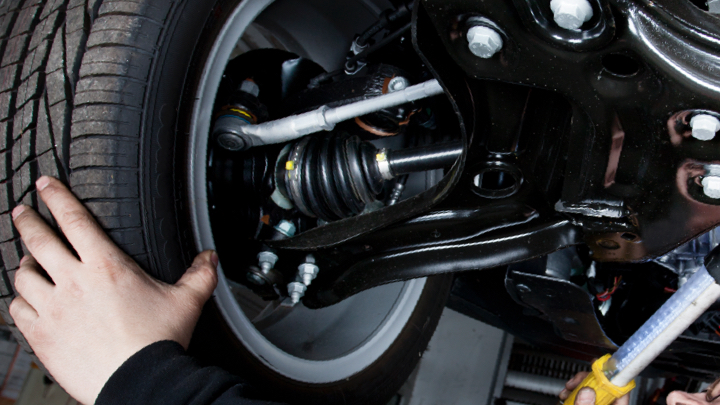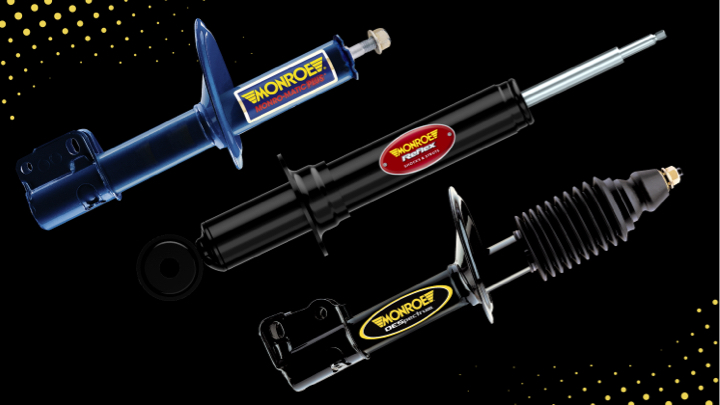
Shocks 101
Shocks vs. struts: What's the Difference?
Role of Shocks and Struts
A key part of your vehicle's suspension system, shocks and struts help keep your vehicle's tires in contact with the road. Why is this so important? If your car doesn’t maintain firm contact with the road, steering, handling and braking can all be affected. Quality ride control products perform many vital functions:
- Control excessive body and tire movement
- Reduce vehicle bounce, roll and sway – plus brake dive and acceleration squat
- Help maintain consistent handling and braking
- Help maintain wheel alignment
- Help reduce the potential of premature wear on tires and other suspension parts
What's the Difference Between Shocks and Struts?
Many times, you’ll hear people refer to shocks and struts interchangeably. However, shocks and struts are two distinct parts with different functions. While both can help with your vehicle’s ride and handling, these parts work in different ways. Shocks are individual components of the suspension system while struts are a major structural component of the chassis and suspension system.
What Do Shock Absorbers Do?
Despite what many people think, conventional shock absorbers do not support vehicle weight. Instead, the primary purpose of the shock absorber is to control spring and suspension movement. This is accomplished by turning the kinetic energy of suspension movement into thermal energy, or heat energy, to be dissipated through the hydraulic fluid.
The amount of resistance a shock absorber develops depends on the speed of the suspension and the number and size of the tiny holes or orifices in the piston. All modern shock absorbers are velocity-sensitive hydraulic damping devices - meaning the faster the suspension moves, the more resistance the shock absorber provides. Because of this feature, shock absorbers adjust to varying road conditions and reduce the rate of:
- Bounce
- Roll and sway from worn shocks losing the ability to control the rate of weight transfer
- Brake dive and acceleration squat
Shock absorbers work on the principle of fluid displacement on both the compression and extension cycle. A typical car or light truck will have more resistance during its extension cycle than its compression cycle. The compression cycle controls the motion of a vehicle's unsprung weight, while extension controls the heavier sprung weight.
Shock Components

Shock absorbers are basically oil pumps. A piston is attached to the end of the piston rod and works against hydraulic fluid in the pressure tube. As the suspension travels up and down, the hydraulic fluid is forced through the orifices inside the piston. However, these orifices let only a small amount of fluid through the piston. This slows down the piston, which in turn slows down spring and suspension movement.
What Do Struts Do?
The strut is a common damper type used on many of today's independent suspension, front wheel drive vehicles as well as some rear wheel drive vehicles.
A strut is a major structural part of a suspension. It takes the place of the upper control arm and upper ball joint used in conventional suspensions. Because of its design, a strut is lighter and takes up less space than the shock absorbers in conventional suspension systems.
Struts perform two main jobs. First, struts perform a damping function like shock absorbers. Internally, a strut is like a shock absorber. A piston is attached to the end of the piston rod and works against hydraulic fluid to control spring and suspension movement. Just like shock absorbers, the valving generates resistance to forces created by the up and down motion of the suspension. Also like shock absorbers, a strut is velocity sensitive, meaning that it is valved so that the amount of resistance can increase or decrease depending on how fast the suspension moves.
Struts also perform a second job. Unlike shock absorbers, struts provide structural support for the vehicle suspension, support the spring, and hold the tire in an aligned position. Additionally, they bear much of the side load placed on the vehicle's suspension. As a result, struts affect ride comfort and handling as well as vehicle control, braking, steering, wheel alignment and wear on other suspension parts.
The Parts of a Strut

Typically, struts consist of a strut housing to provide rigid structural support for the assembly and a damping unit within the strut housing to control spring and suspension movement. On most struts, the bottom of the body attaches to the steering knuckle, which in turn connects to a lower control arm through a lower ball joint.
A complete strut assembly includes all the components needed for strut replacement in a single, fully-assembled unit. It combines the strut housing, damping unit with a coil spring to support the vehicle's weight.
How Many Shocks or Struts Does My Vehicle Have? Where Are They Located?
Every wheel on your vehicle has either a shock or strut. However, your vehicle could have shocks on the front and struts on the back or some other configuration. The key takeaway is that each wheel has some sort of ride control part.
Learn more about quality shocks, struts, and strut assemblies, find the right car part, or find a local repair shop today.
The content in this article is for informational purposes only. You should consult with a certified technician or mechanic if you have questions relating to any of the topics covered herein. Tenneco will not be liable for any loss or damage caused by your reliance on any content.